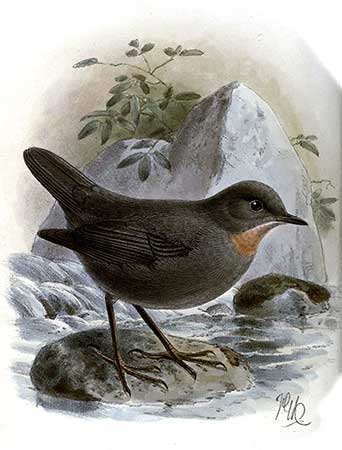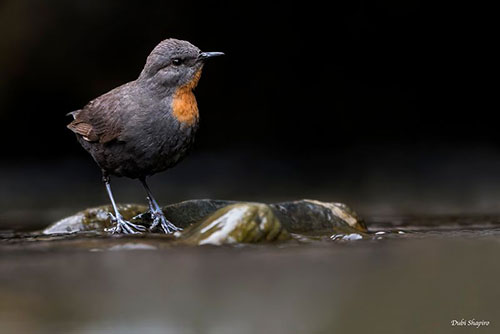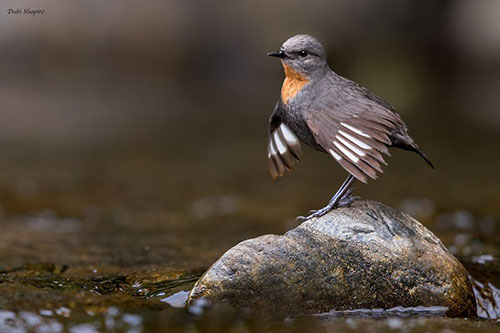
PROTECTION / THREATS / STATUS:
The Rufous-throated Dipper has restricted range in which it is threatened by alteration of river channels and pollution at lower elevations.
In Argentina, the riverine habitats are threatened by reservoir construction, irrigation and eutrophication. Soil erosion caused by livestock-grazing is a significant problem too.
But this species has most part of its habitat naturally protected by its inaccessibility.
The population is roughly estimated to number 2,000/2,700 mature individuals and is slowly decreasing.
The Rufous-throated Dipper is currently listed as Vulnerable.
Fr: Cincle à gorge rousse
Ang: Rufous-throated Dipper
All: Rostkehl-Wasseramsel
Esp: Mirlo-acuático Gorgirrufo
Ita: Merlo acquaiolo golarossiccia
Nd: Roodkeelwaterspreeuw
Sd: roststrupig strömstare
Photographer:
Dubi Shapiro
Dubi Shapiro Photo Galleries
Illustrator :
John Gerrard Keulemans (1842-1912)
Illustration’s Origin:
Argentine ornithology. A descriptive catalogue of the birds of the Argentine Republic
Text by Nicole Bouglouan
Sources:
HANDBOOK OF THE BIRDS OF THE WORLD Vol 10 by Josep del Hoyo-Andrew Elliott-David Christie - Lynx Edicions - ISBN: 8487334725
WRENS, DIPPERS AND THRASHERS by Brewer David – illustrated by Barry Kent Mackay- Yale University Press - ISBN: 0300090595
Neotropical Birds – Cornell Lab of Ornithology
The Rufous-Throated Dipper By Alex Ward
Family Cinclidae
Page Passeriformes Order
Summary cards
Rufous-throated Dipper
Cinclus schulzii
Passeriformes Order – Cinclidae Family
INTRODUCTION:
The Rufous-throated Dipper is a restricted-range species found in S Bolivia and NW Argentina. This dipper frequents the fast-flowing mountain streams and rivers and breeds at high elevations. It performs some altitudinal movements during the colder period.
This species is threatened by increasing development throughout the range, with alteration of river channels and pollution at low elevation, and degradation of the habitat by livestock. However, several sites are inaccessible and naturally protected. But the population is very small and slowly declining.
DESCRIPTION OF THE BIRD:
Biometrics:
Length: 14-15 cm
Weight: 37-40 gr
The Rufous-throated Dipper adult has dull brownish-grey entire upperparts, with more rufous forehead and lores. Wings and tail appear slightly darker. A white wing patch is visible on open wings, formed by white bases of inner webs of primaries.
On the underparts, the chin is greyish and contrasts with the orange-rufous patch extending from throat to upper breast. The lower breast is dull grey whereas rest of underparts are grey-brown, darker on belly. The underwing is grey with broad white band at bases of primaries.
The bill is dark grey to black. The eyes are dark brown to blackish. Legs and feet are dark grey.
Male and female have similar plumage, but the female is slightly smaller than male.
The juvenile is paler than adults and it has pink bill.

John Gerrard Keulemans
(1842-1912)
RANGE:
The Rufous-throated Dipper is found in E Andes in S Bolivia (S Chuquisaca and W Tarija), and in NW Argentina (Jujuy, Salta, Catamarca and Tucumán).
HABITAT:
The Rufous-throated Dipper frequents fast-flowing rocky streams and rivers in mountains, especially with waterfalls, rocky cliffs and banks.
It breeds in the alder zone (Alnus acuminata) between 1,500 and 2,500 metres of elevation, and sometimes higher. In Bolivia, it is suspected to breed around 1,200 metres on streams in pastures.
During the cold period, it descends to 800 metres and can be found on larger rivers.
CALLS AND SONGS: SOUNDS BY XENO-CANTO
The Rufous-throated Dipper’s call is a loud “zeet zeet” often given in series becoming faster in flight.
The song is a loud, flute-like warbling or trill, fairly similar to that of the White-throated Dipper.
BEHAVIOUR IN THE WILD:
The Rufous-throated Dipper feeds on aquatic insects and larvae. It feeds usually on mayfly’s nymphs (Ephemeroptera) and also Thrichoptera. It may consume small molluscs too, depending on the area.
It perches on rock in the water, and moves down to the water edge, picking prey from the rock at water surface or below. It also wades in shallower areas or waits at the edges of waterfalls while flapping its wings to maintain its balance in the fast-flowing current. It also performs head-dipping, but this species has never been observed swimming or diving for prey like other Cinclus species.
Between feeding bouts, the white wing patch is flaunted by a wing flicking motion. Bobbing is also observed while the bird perches on rock above the water, accompanied by aggressive shakes of the head and wing flicking.

The Rufous-throated Dipper is probably monogamous and solitary nester. The nest is very similar to that of the White-throated Dipper, in spite of the smaller size of the bird.
The courtship displays are not described, but we can suggest that the rufous throat patch and the white wing patches are enhanced by adapted postures and movements.
This bird is territorial and defends a part of the river, between 500 and 1,000 metres along the river, sometimes more.
The Rufous-throated Dipper is resident and only performs altitudinal movements in cold weather.
It performs short flights between its foraging sites.
REPRODUCTION OF THIS SPECIES:
The breeding season occurs from September to January.
The Rufous-throated Dipper builds a globular structure with side entrance hole. It is made with moss and grass outside, whereas the interior is made with grass stems, algae and Alnus leaves. Some feathers are sometimes added.
The nest is 24 centimetres high and 14 centimetres deep. It is placed in rock crevice or cliff ledge, in hole in rocky wall, on tree roots or under bridge, usually between 0,5 and 1,25 metre above the fast-flowing water.
The female lays two white eggs and both parents feed the chicks.
